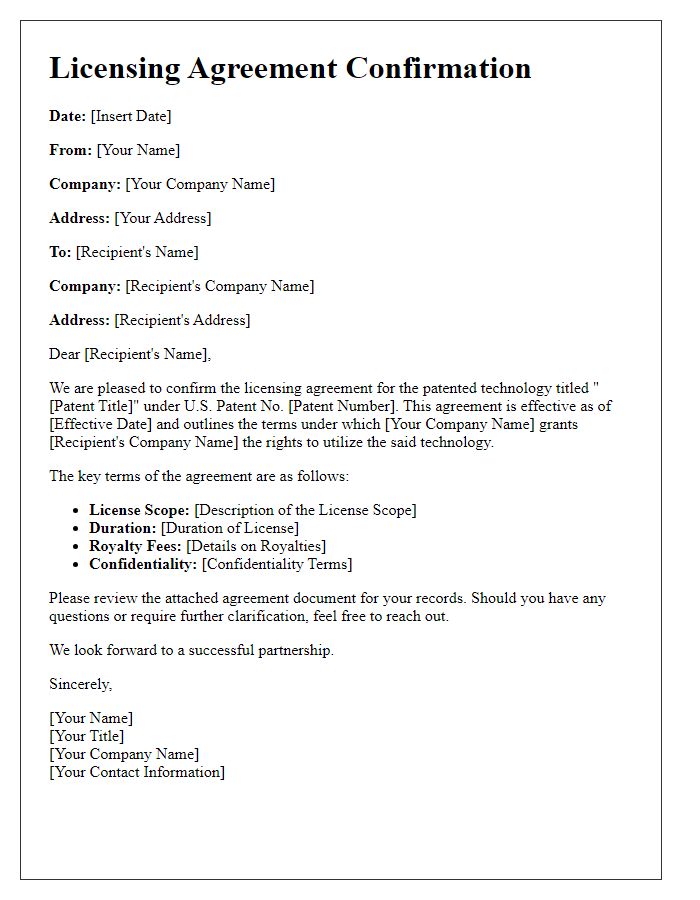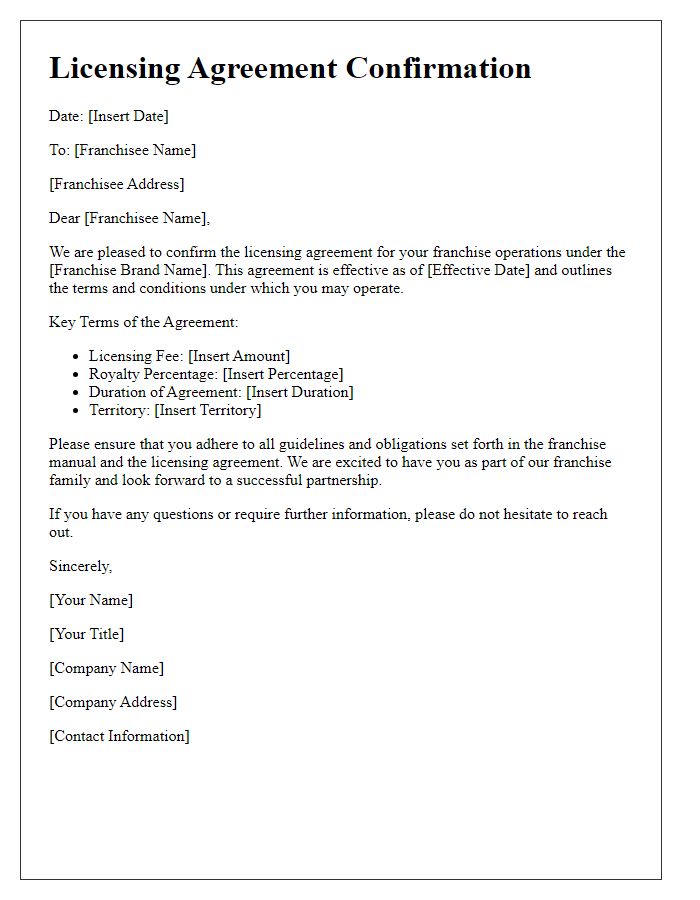Are you looking to draft a confirmation letter for a licensing agreement? This important document helps ensure that both parties are on the same page regarding the terms and conditions of the license, and it's not as daunting as it may seem. In this article, we'll walk you through a sample template that outlines the key elements you need to include for clarity and compliance. So, let's dive in and explore how to create an effective confirmation letter for your licensing agreement!

Clear Identification of Parties
The confirmation of a licensing agreement between two parties must clearly identify the participants involved in the contract. The Licensor, ABC Technologies Inc., headquartered in San Francisco, California, specializes in advanced software solutions for data analytics. The Licensee, XYZ Innovations Ltd., located in Austin, Texas, focuses on developing cutting-edge mobile applications. The agreement pertains to the use of proprietary software known as DataMax, designed to optimize processing efficiency. Each party's roles, responsibilities, and contact information should be included to ensure clear communication and legal compliance throughout the duration of the agreement. Additionally, specific details regarding the scope of the licenses granted, such as geographic limitations or duration, must be stated to prevent future disputes.
Detailed Licensing Terms and Conditions
A licensing agreement serves as a crucial document in business partnerships, establishing the terms and conditions governing the use of intellectual property (IP). The licensing terms detail the scope of rights granted, such as the duration (often ranging from one to five years), geographic limitations (often specified to regions like North America or the European Union), and any royalties or fees involved (typically calculated as a percentage of revenue generated from the licensed IP). Conditions may include quality control measures to maintain brand integrity and provisions for dispute resolution, often outlining jurisdiction (such as a governing law from a specific state or country). Understanding these details ensures compliance and protects the interests of both licensors and licensees.
Duration and Renewal Options
In a licensing agreement, the duration specified determines the length of time the license is valid, often ranging from one to five years. For example, a five-year agreement provides greater stability and assurance for both parties involved, typically starting from the effective date stated in the contract. Renewal options play a crucial role, allowing parties to extend the agreement without renegotiating terms. These options could include automatic renewal clauses, where the license extends for additional terms unless terminated with advance notice, commonly 30 to 90 days. Additionally, specific conditions--such as performance metrics or compliance with industry standards--may need to be met to trigger the renewal. Thus, clarity on these points ensures a mutual understanding of rights and obligations throughout the licensing term.
Payment and Royalties Structure
A licensing agreement outlines the payment and royalties structure between parties involved, such as a brand owner and a licensee. The agreement specifies initial licensing fees, often a one-time payment calculated based on projected sales figures, alongside ongoing royalty payments, typically a percentage (5% to 15%) of gross sales revenue generated from licensed products. Payment terms, including the frequency of royalty payments, might be defined as quarterly or annual, ensuring transparency and accountability. Additionally, the agreement could detail sales thresholds triggering minimum guarantees, providing security for the brand owner while incentivizing the licensee to maximize sales. Compliance with tax obligations and audit rights for financial examinations should also be stipulated to ensure fair distribution of royalties.
Confidentiality and Intellectual Property Rights
A licensing agreement outlines the terms under which one party licenses intellectual property (IP) to another party. This document ensures confidentiality and clearly defines intellectual property rights, protecting sensitive information and legal claims. Common attributes of licensing agreements include specific licensing terms, scope of use, fees, and provisions for renewing or terminating the agreement. For example, the agreement may specify that the licensed IP includes patents, trademarks, or copyrights related to a product developed by a technology company headquartered in Silicon Valley. Additionally, the confidentiality clause prohibits the disclosure of proprietary information to unauthorized third parties, safeguarding competitive advantages and trade secrets. Compliance with relevant laws, such as the Digital Millennium Copyright Act (DMCA), may also be included to ensure adherence to legal standards governing IP.
Letter Template For Confirmation Of Licensing Agreement Samples
Letter template of licensing agreement confirmation for software distribution

Letter template of licensing agreement confirmation for educational materials

Letter template of licensing agreement confirmation for brand partnership

Letter template of licensing agreement confirmation for patented technology

Letter template of licensing agreement confirmation for franchise operations

Letter template of licensing agreement confirmation for publishing contracts

Letter template of licensing agreement confirmation for merchandise rights

Letter template of licensing agreement confirmation for film distribution






Comments